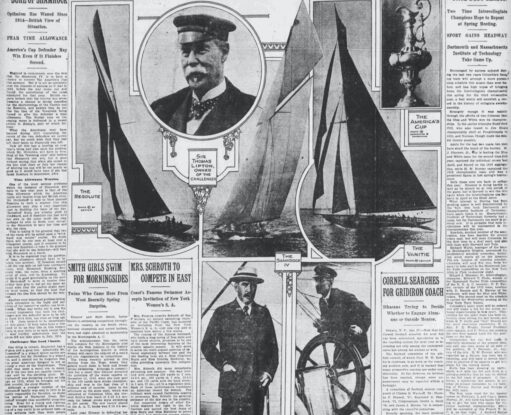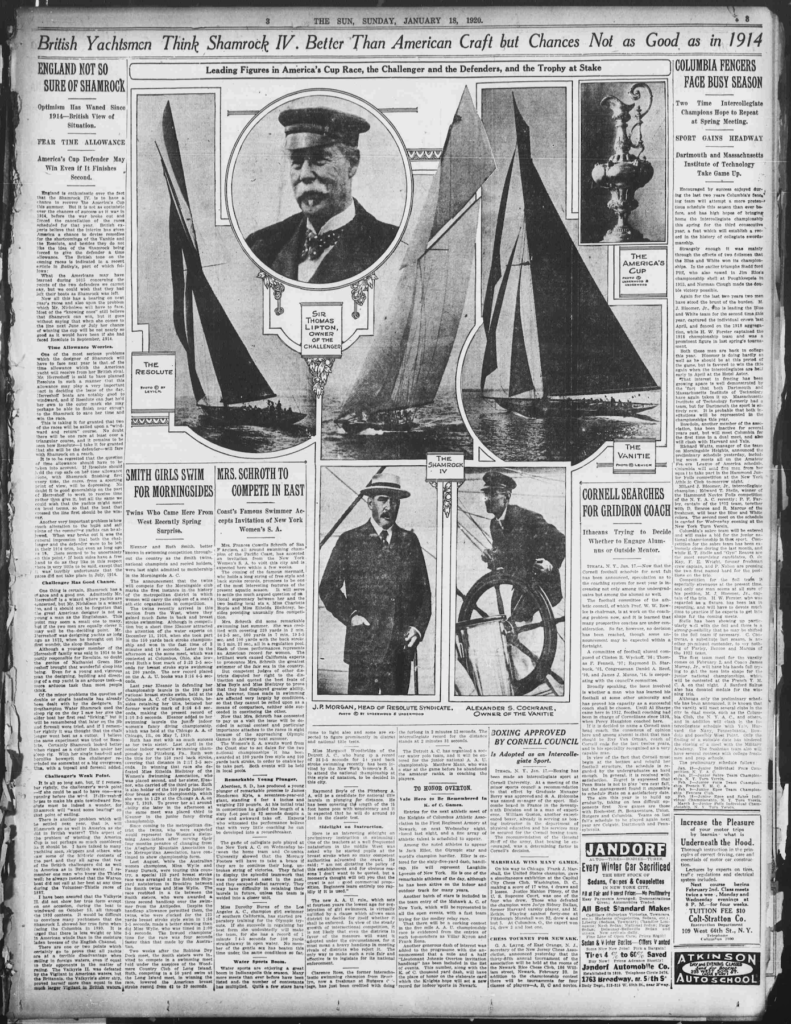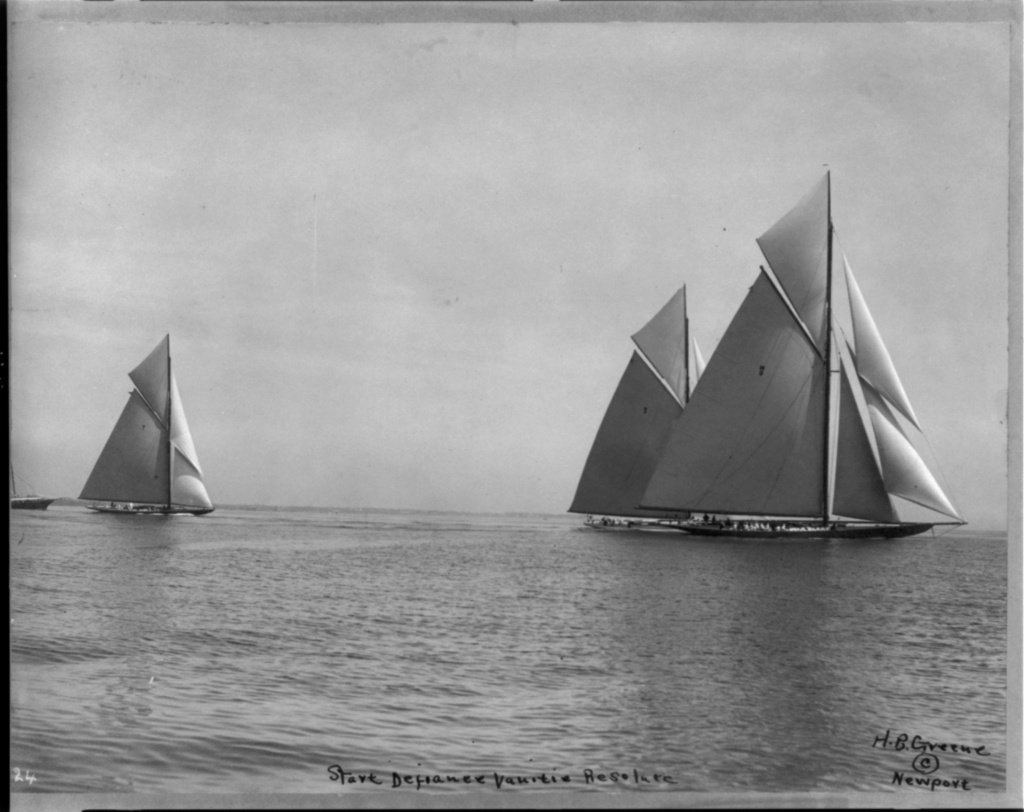August 27, 2020
The Curator’s Log: The 100th Anniversary of RESOLUTE’s Defense and the 13th Challenge (Part II)
The Trials of 1914

Part Two: The Trials of 1914
By John Palmieri, Curator Emeritus
In the autumn of 1913 three prospective Cup defenders are under contract. The first to launch the following April is the NYYC syndicate’s Herreshoff designed and built RESOLUTE. She is now gone, but her half-model is available for all to see in the model room of the Herreshoff Marine Museum. What is not seen are the challenges Capt. Nat Herreshoff overcame to achieve the early successful launching.
The NYYC Defender Syndicate- RESOLUTE
As early as August 27, 1913 correspondence between Capt. Nat and George Cormack discuss plans for a meeting to which Nat will bring “the two models” so one can be accepted. He does visit the syndicate in New York between the 1st and 4th of Sept., but no record of the meeting has been found. [1]
We do know that Nat’s Naval Architecture and Engineering Notes include design data for four Cup defender models (A to D) written over the 2½ weeks beginning the 8th of September 1913.[2] The surviving RESOLUTE half-model “D” is the last to be carved. All are for a 75-foot waterline, but vary in overall length, quarter beam length, beam, bottom of keel length, displacement and wetted surface. Ballast to displacement ratios range from 50 to 59%. One, Model “C”, is not a carved model, but is the half-model for Alexander Cochran’s racing schooner WESTWARD adjusted to a new scale and increased in linear dimensions. (Perhaps this was Nat’s look at a defender for Cochran and not a design for the NYYC syndicate.)
Construction of RESOLUTE on the ways starts on Nov. 7th. By then Nat has completed his rigging strain calculations, details of the rigging to be ordered and the list of sails. On Dec. 12th, within a few hours of pouring the lead keel he discovers an error in his calculations- the keel is “much to light”. By Dec. 18th he has decided to throw away the manganese bronze keel plates and cast added lead on top of the present casting. This is done the day after Christmas and new keel plate sections are cast the following day. On Saturday Jan 31,1914 he records the final lead keel weights and leaves for Bermuda (to free himself from the debiltating effects of the cold and dampness on his rheumatism) the next Tuesday, after first meeting with the syndicate in New York.[3]
His Bermuda stay is a short seven weeks and he returns to see the hull plating completed and direct the launching at 6:30 PM Saturday April 25th. (All HMCo Cup boat launchings were on a Saturday evening to minimze impact on both the workday and workweek.) She has white topsides, a burnished bronze underbody, a keel sheathed in bronze and wood rudder. RESOLUTE resembles a NY 50 with short overhangs; “she looks as though she were built to get all the allowance she could from the others, both of which are larger”.[4] RESOLUTE is trialed on May 3rd and delivers on May 12th following the fitting of a new centerboard.
George M. Pynchon Defender Syndicate- DEFIANCE
The George Owen designed DEFIANCE is the next in the water; on Monday May 11th she slides down the ways at the Bath Iron Works stem first. DEFIANCE is composite construction with steel frames and a double–planked wood hull; 1¼ mahogany over ¾ fir. She has the tallest rig and is the beamiest of the three. To keep costs down the work is spread among about six firms; BIW steel framing and assembly; Hodgdon Bros. woodwork, planking and deck; others for spars, blocks, fittings, and sails.
Alexander Cochran’s Defender- VANITIE
The William Gardner designed VANITIE is launched by Lawley’s on Thursday May 14th. She is “a ship of burnished bronze” with a bronze hull finished bright.VANITIE is lightly constructed with the thinnest plating 7/64th of an inch. Her rig is not as tall as DEFIANCE, but it is longer on the baseline and the spread of canvas is about equal. [5]
The Defender Trials
In April the NYYC announces the schedule of elimination races. June races will not be counted as they are, “to allow the craft to make any experiments they choose and also to train crews”. A total of 35 elimination races are planned thereafter, ending in the three trial races off Newport in mid August.[6]
When the races start the press and others are pulling for VANITIE; “RESOLUTE is not the popular favorite, her designer and builders are universally disliked, and the majority of yachtsmen for this reason would rejoice to see the Herreshoff boat beaten by VANITIE. Gardner is an exceedingly affable and approachable man…has done much …to aid the pastime, and for that reason yachtsmen, and especially the newspapermen would like to see his boat chosen…”.[7]
Twenty races are held before RESOLUTE is declared the Defender with 15 firsts out of 18 starts. Many are very close wins over VANITIE who must give 1 min. and 46 sec. to the lower rated RESOLUTE. VANITIE has five firsts out of 20 races, including two wins when RESOLUTE does not start. DEFIANCE, never fully tuned up, and beset with rig failures has no wins in only ten starts. She will not race again.[8]
The Challenger SHAMROCK IV
The challenger is the last to launch on Tuesday May 26th from the Camper and Nicholson yard in Gosport. For Charles E. Nicholson, 20 years Nat’s junior, this is his first America’s Cup design, and his first experience with the American Universal Rule. His boats have competed in European waters against Herreshoff designs in the ½ and 2½ rater classes, and his new schooner MARGHERITA has beaten the three-year-old WESTWARD (the latter without the services of Charlie Barr). When asked to assess his take away from that experience Nicholson cautions, “we must remember our boats have only raced against American boats in our home waters under our rules instead of their which makes an enormous difference”.[9]
Nicholson was the first to apply lightweight laminated wood to sailing yachts. SHAMROCK IV’s hull is a mahogany laminate (two ½ inch diagonal plys covered by one ¾ inch fore and aft ply) on steel frames with diagonal struts to provide rigidity. The decks consist of lightweight ¾ inch thick panels of five ply pressed birch veneer on light steel beams. She has a lofty rig with the topmast socketed into the mainmast as Herreshoff had done in RELIANCE.[10]
SHAMROCK IV departs Falmouth England on July 21st for New York by way of the Azores in company with Sir Thomas Lipton’s steam yacht ERIN. On August 4th they learn by wireless that England has gone to war with Germany. The following evening they are ordered to the nearest friendly port. Bermuda, some 450 miles distant, is chosen rather than Halifax because the track to Halifax crosses shipping lanes vulnerable to prowling German cruisers whose coded messages are filling the airwaves. They eventually make safe passage to New York arriving on August 17.[11] [12]
This ends the plans for a 1914 Cup. SHAMROCK IV is laid up in the US. ERIN returns to serve in the Royal Navy as a hospital ship and later as a patrol vessel until sunk by a German submarine.
In the next Curator’s Log we complete the story of the 13th Challenge with the 1920 Cup races.
John Palmieri
John Palmieri
Originally published in the HMM Curator's Log, November 2015
[1] George Cormack to NGH letters of 8/27 & 8/29/1913 Herreshoff Marine Museum, NGH Collection Subject Folder; RESOLUTE and Her Construction 1913-14. NGH Diary 9/1 & 9/4/1913. Access to all letters in the RESOLUTE folder and NGH Diary courtesy of Halsey C. Herreshoff.
[2] Capt. Nat’s practice was to record the design description and calculations of each design in a series of Naval Architecture and Engineering Notes. Access to this material is courtesy of Halsey C. Herreshoff.
[3] All dates and events through delivery of RESOLUTE are from the NGH diary or his NA & E Notes.
[4] Fred W. Goeller, Jr. ”Launching of the Cup Defense Candidates”, The Rudder, Vol. XXX No. 6 June 1914. Pgs 285-288.
[5]DEFIANCE and VANITIE quotes and details from F. W. Goeller. ”Launching of the Cup Defense Candidates”.
[6] “Dates for Elimination Races to Select a Cup Defender”, The Rudder, Vol. XXX No.4 April 1914. Pg 184.
[7] Thomas Fleming Day, President The Rudder Publishing Co. “The Trials and Travails of the Three Cup Boats”, The Rudder, Vol. XXX No. 8 August 1914. Pg 367
[8] L. Francis Herreshoff. An Introduction to Yachting. Sheridan House, White Plains NY 1963. Pg. 178.
[9] J. Rendell Wilson, “SHAMROCK IV’s Designer”. The Rudder, Vol. XXX No. 1 Jan. 1914. Pg 1.
[10] Thomas Fleming Day, “SHAMROCK IV: What She is and Her Chances of Winning the Cup”. The Rudder Vol. XXX No. 7 July 1914. Pgs 349-54.
[11] Colonel Duncan F. D. Neill, “Voyage of SHAMROCK IV from Falmouth to New York”, The Rudder Vol. XXX No. 9 Sept 1914, Pgs 429- 33.
[12] Photo of NGH aboard RESOLUTE from Museum archives. Other photos from The Rudder


